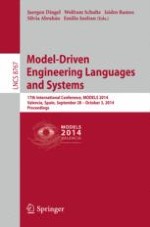This book constitutes the refereed proceedings of the 17th International Conference on Model Driven Engineering Languages and Systems, MODELS 2014, held in Valencia, Spain, in September/October 2014. The 41 full papers presented in this volume were carefully reviewed and selected from a total of 126 submissions. The scope of the conference series is broad, encompassing modeling languages, methods, tools, and applications considered from theoretical and practical angles and in academic and industrial settings. The papers report on the use of modeling in a wide range of cloud, mobile, and web computing, model transformation behavioral modeling, MDE: past, present, future, formal semantics, specification, and verification, models at runtime, feature and variability modeling, composition and adaptation, practices and experience, modeling for analysis, pragmatics, model extraction, manipulation and persistence, querying, and reasoning.
